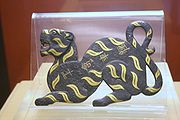
Fu (tally)
Encyclopedia

Hu-fu
The two-piece tiger tallies (hu-fu, 虎符 in Chinese) were used by an emperor to command and dispatch the army. The right piece was retained in the central government while the left piece was issued to the local officials or commanders. If someone wanted to dispatch the troops from a certain area, he had to show the right piece of the tiger tally in order to obtain authorization; both pieces of the tally had to match each other. The word hu-fu first appears in the biography of Hsin-ling in the Records of the Grand HistorianRecords of the Grand Historian
The Records of the Grand Historian, also known in English by the Chinese name Shiji , written from 109 BC to 91 BC, was the Magnum opus of Sima Qian, in which he recounted Chinese history from the time of the Yellow Emperor until his own time...
, which tells the story of the stealing of a tiger tally to relieve the state of Zhao
Zhao (state)
Zhao was a significant Chinese state during the Warring States Period, along with six others...
. During the Warring States period this kind of fu was changed from jade to bronze.

